Caroline Bartlett: Embroidering the truth
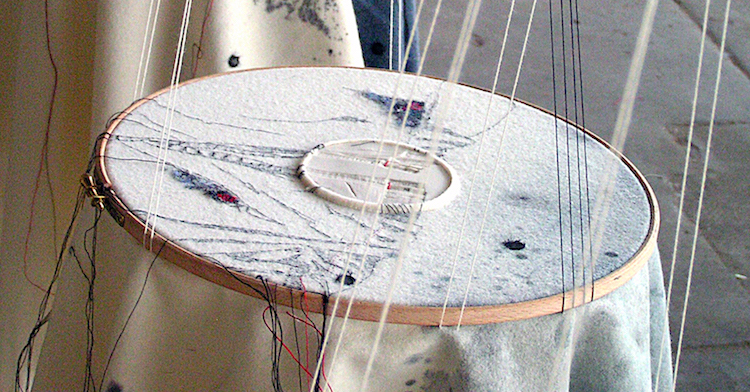
In her work, Textile Artist Caroline Bartlett explores the historical, social and cultural associations of textiles and their ability to trigger a memory.
Imprinting, stitching, erasing and reworking, folding and unfolding become defining characteristics, whilst explorations have also resulted in works which integrate textiles with other media such as porcelain.
Caroline has enjoyed a long association with the Whitworth Art Gallery, Manchester since being commissioned by them in 2003. Recent exhibitions include Rijswijk Textile Biennial, Rijswijk, Holland, 2015 and Cloth and Memory, Salts Mill, Saltaire, Bradford, 2013.
In 2014 Caroline achieved the Award of Excellence at the 8th International Fiber Art Biennale; From Lausanne to Beijing, Nantong, China.
Caroline is a member of the 62 Group, Contemporary Applied Art.
In this interview, Caroline discusses her journey into the world of textile art and we learn about her preferred materials and techniques. We discover how travel has influenced her art but also how circumstances closer to home inspired an eye-catching group of pieces.
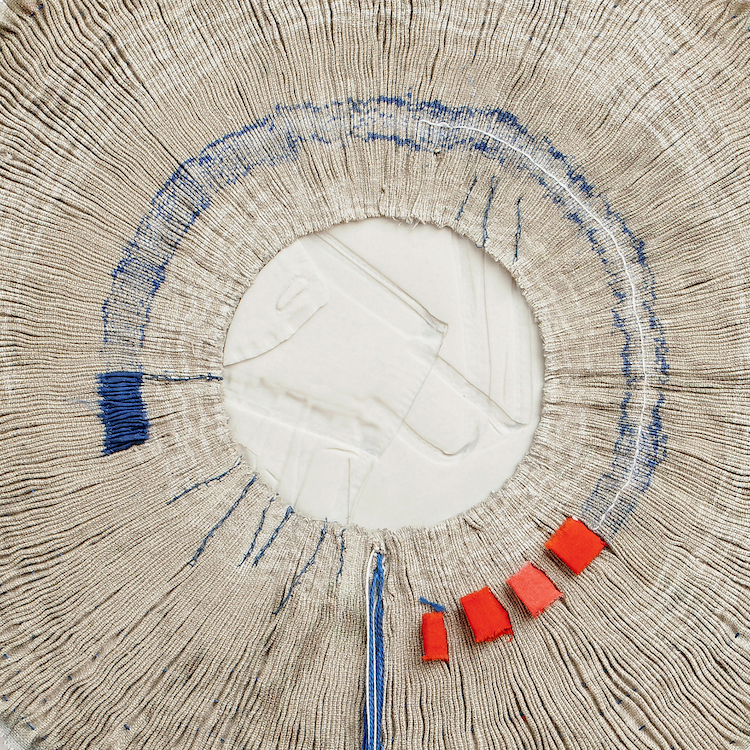
Caroline Bartlett, Full Circle, 2016 detail
The embodiment of memory
TextileArtist.org: What initially attracted you to textiles as a medium?
Caroline Bartlett: I had plans for myself as a 3D Designer, an ambition which turned on its head on Foundation at Kingston where I found my strengths lay in the 2D sphere. Weekends were spent browsing the Victoria and Albert Museum and I discovered those wonderful pullout drawers that were in the textile section; each a total surprise.
I followed this burgeoning interest through on a BA course in printed textiles at Central. It was however at a time when printed textile design was carried out in flat painted gouache and I spent my last year going partially against the prescribed grain and trying rather unsuccessfully to exploit and develop surface qualities through knitting and quilting, without being clear what it was that engaged me. Later, on the Post Graduate Textile Diploma course at Goldsmiths, I started to explore print in combination with methods of manipulation and had my answer.
As the years have gone on, I have become increasingly interested in what textiles can do through their varied and distinctive behavioural properties, and what they can say through their materiality, tactility, associations with the body and the domestic, and with a colonial and industrial past.
Textiles have a history in which the embodiment of memory is culturally encoded and they can be a powerful trigger in stimulating individual or collective memories. I find it an incredibly rich area. Stitch, with its strong associations of mending and repair, opens up a language beyond simply process and technique.
And, more specifically, how was your imagination captured by stitch?
My early childhood was spent abroad and my mother used to make our clothes and use stitch to decorate household linens. I never took to making garments but I did play around with the offcuts and embroider small presents. The application of stitch to my own work came largely as a result of the course at Goldsmiths, using stitch initially as a structuring device.
It slowly escaped from this role into becoming a part of the surface in a series called Notations which drew on etymological links between text (derived from the Latin textus; from texere/textum -to weave) and textile and connections with textiles in language expressions; ‘embroidering the truth’, ‘spinning a web’ and so on.
I became interested in the notion of the written word as an authenticating device, embodying knowledge and power. It can become tangled and deceive, and used for propaganda purposes. Histories get omitted, overwritten and erased, books get burnt.
Storeys of Memory I and II were made in response to the Weiner Library, an archive which documents the history of National Socialism, alongside other incidents of genocide. The work makes reference to the propaganda tracts and the burning of books which are such terribly prevalent means employed in the destruction of cultural identity.
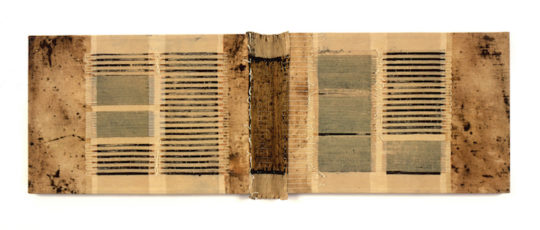
Caroline Bartlett, Storeys of Memory I, 2002, 33 x 101.5 x 3 cm, Discharge and stitch resist, pleated, stitched
Guardians of knowledge
A commission in 2000 undertaken as part of Art Textiles on the site of the library in the ruins of the abbey in Bury St Edmunds took these ideas in a different direction. The keeping, making and copying of books by hand was undertaken by the monks placing them in a powerful position as guardians of knowledge. The dissolution of the monasteries brought with it the destruction, burning and scattering of the archive.
In the temporary installation, ‘Codices’, the Latin text is taken from an old manuscript of St Benedicts’ rules for monks, was deliberately illegible as the words were partially erased and digitised. Two large letters were burnt into the grass and these were combined with other fragmented markings which were constructed to appear as though stitched into the grass. The intention was that the letters forms would be slowly erased as nature took over and blades of grass gradually pushed through the stitching.
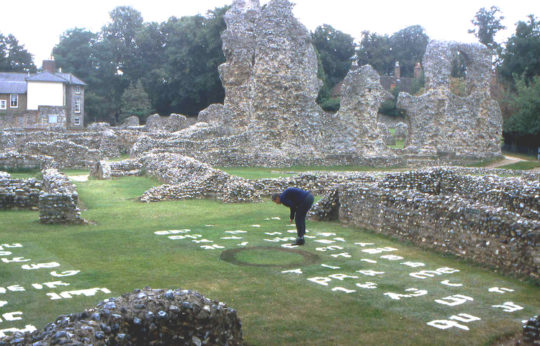
Caroline Bartlett, Codices, 2000, 12 x 10m, stitched metal mesh
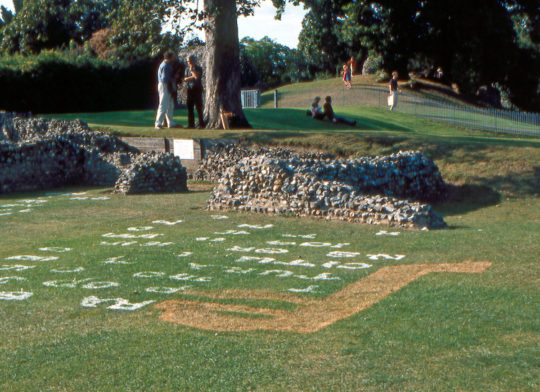
Caroline Bartlett, Codices, 2000, 12 x 10m, stitched metal mesh 2
Nylon thread was stitched onto a metal mesh, and thirteen people contributed to this as a work. Although each person had a set of identical instructions, each individual stitched differently. I was fascinated at how the individuality of the stitch echoed that of handwriting.
I started to use hand stitch and fabric as the sole method of image representation when my father got Alzheimer’s and I was backwards and forwards down to Dorset by train. Stitch can be a mobile medium and it suited my fractured time but also my ideas.
I had watched my mother degenerate with the same disease and forget how to stitch or knit. Responses, based previously around public memory became more personally rooted. I stitched my way through these journeys, running stitches under the skin of the cloth.
Previous pleated and folded works were scanned and then redrawn through stitch: a process of archiving former works, contemplation, and reflection. This led to a series of five pieces called Surrogates and also to Backwards, Forwards.
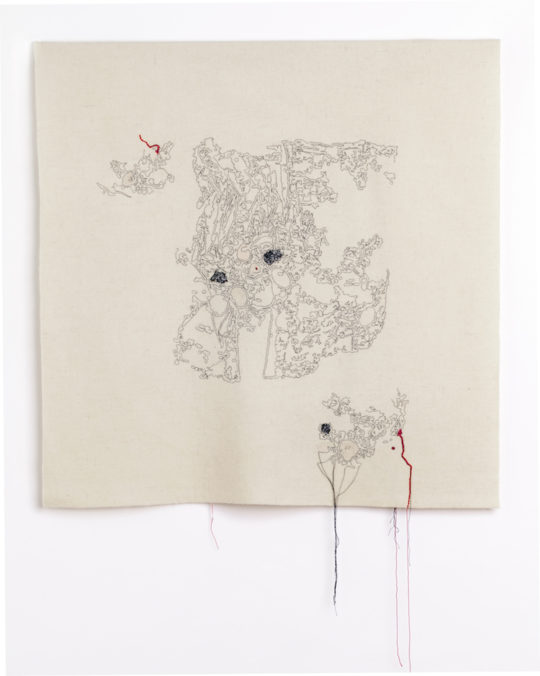
Caroline Bartlett Surrogate ll, 2010, 72 x76 cm
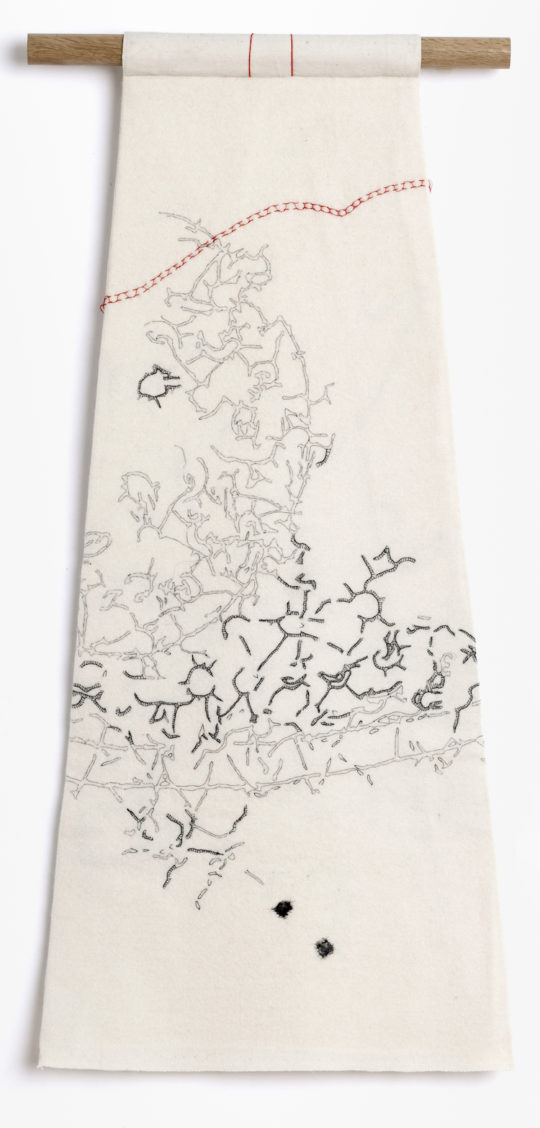
Caroline Bartlett, Backwards, Forwards, 2011, 34 x 317 cm, detail hand stitch
Repetitious activity
What or who were your early influences and how has your life influenced your work?
Having lived abroad in my early years and travelled a lot, I developed a passion for visiting and experiencing remote and less remote corners of the earth. These trips always involved searching out the indigenous textile traditions, amongst them, for example, the embroidered and pleated skirts of the Hmong.
The influences of what was seen or experienced on these trips might be quite conscious or linger in the subconscious and I can see evidence of how trips to Japan and the Far East has informed my aesthetic.
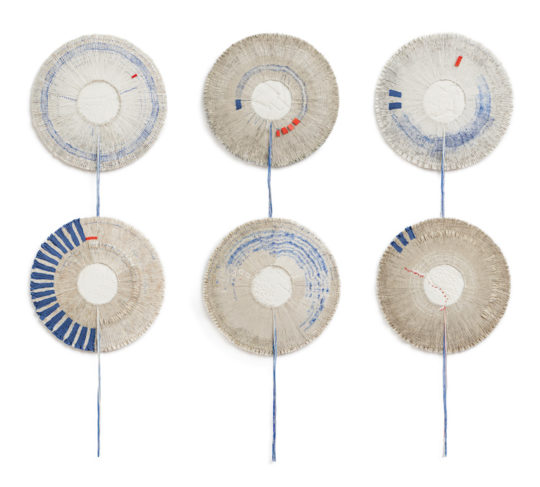
Caroline Bartlett, Full Circle, 2016, 101 x 117cm, printed, stitched linen, porcelain
As a result of these journeys, I have a large photographic archive to draw on and this has fed into several pieces.
I made specific use of my archive of people engaged in making textiles in Conversation Pieces; a commission from the Whitworth Art Gallery to work in response to their textile collection. Here the hands and activities of conservators at work are interleaved with those of these practitioners. Both are engaged in an intensive, detailed and repetitious activity involving a high level of skill and knowledge.
Carers of the collection have endeavoured to fill gaps in the history, and detail of the object, piecing together information across time and space. Textual reference printed on the hoops suggests vulnerability and fragility as outlined in the archival records.
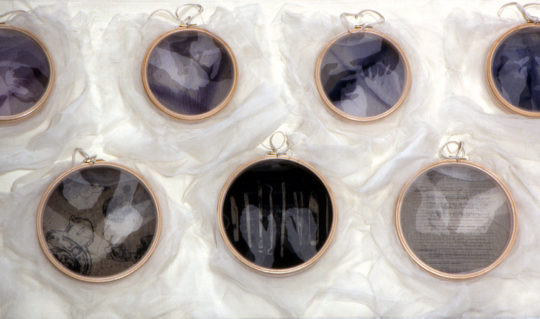
Caroline Bartlett, Conversation Pieces, 2003, 272 x 74 x 5cm, printed, stitched
What we choose to preserve
What was your route to becoming an artist?
After a BA course in printed textiles, I worked for a while as a freelance textile designer, but never really finding my footing, and then for a commission printer. Here my creative energy was focused on the rigours of repeat and the needs of the client. A decision to have a more hands-on engagement with the stuff of textiles took me to study at Goldsmiths.
Then, ten years later, I undertook an MA in Public Art. This again refreshed my practice, challenged my thinking and gave me more of a theoretical grounding. The focus of my work moved into examining the role played by various sites of production and representation, such as historic locations, museum collections, archives and encyclopaedias in shaping individual and collective identities, memories and value systems, determining what we choose to preserve, which stories we tell and how we tell them.
Bodies of Knowledge Volume 5, Arbiters of Taste is one of a series of 1934 encyclopaedias with which I have intervened. Volume 5 makes reference to the Victoria and Albert Museum, as an encyclopaedia of treasures, reflecting governing ideologies and hierarchies of taste. Open at pages on Interior Design, the encyclopaedic text belies objectivity in advising readers to rip out ugly Victorian fireplaces.
The Art Nouveau chairs depicted in the rings on the margins of the work refer to the donation of thirty-eight pieces from the Paris Exposition Universelle in 1900. This collection was reviled by critics and ‘banished’ to the Bethnal Green Museum. These pieces were later recognised as prime examples of their type.
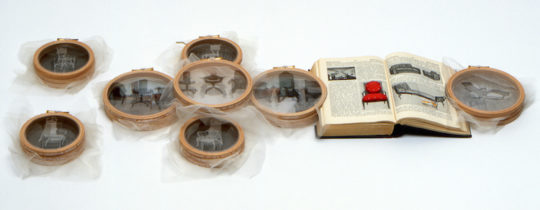
Caroline Bartlett, Bodies of Knowledge, Volume V Arbiters of taste, 2002
This critique is now in the collection of the Victoria and Albert Museum.
Tell us a bit about your chosen techniques.
Whilst at Goldsmiths, I developed a vocabulary of marking and printing, erasing and reworking, pleating and manipulating, reworking, finding the alchemy in materials and processes. The cloth retains these workings as traces. It might be held under tension or folded backwards and forwards to conceal and reveal, as a memory might be folded away.
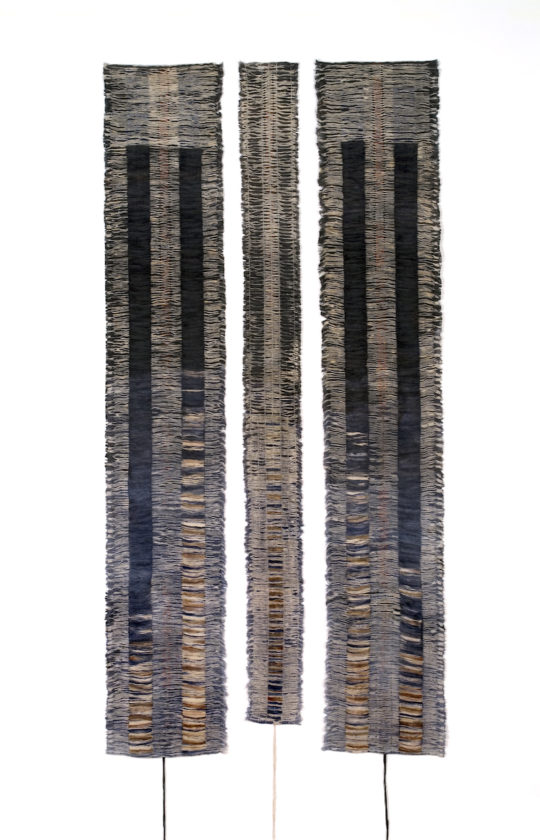
Caroline Bartlett, Shadows, 2005, 68 x 169cm
Technical pursuits have been further consolidated by two trips to Japan specifically to look at shibori and its use in the sculpting of synthetic fabrics.
However, although these processes form the bedrock of my practice, I am constantly looking to use techniques which nuance the particular idea I am working on so the techniques I use change accordingly. Although certain techniques may be carried through from one project to the next, this means that I am involved in a constant process of testing materials, and technique in relation to concept.
How do you use these techniques in conjunction with stitching?
In Stilled, I have used stitch in conjunction with imprinted porcelain. The work was part of Cloth and Memory; at Salts Mill near Bradford. The specific location was critical to the work: the huge now silent spinning hall, a place suffused with atmosphere, still smelling of its former life with oil stained floors and bits of yarn caught in cracks and crevices; an unreconstituted space. There is a strong sense of presence, and absence, of a bygone era of industrial manufacture when industries such as textile and ceramics were central to the economic life of Britain.
The mill is embedded in the environment through architectural, cultural and social structures. Notions of skin, bone, membrane; a layered dermis, came to mind in my explorations together with ideas of networks of social and commercial relations, and of cloth as a witness to the routines of daily lives.
The techniques here employ porcelain as the centre of each piece, imprinted with elements of clothing, a cuff, collar, bit of folded fabric. The stitch traces these elements out into the tensioned surface. The work also employs labels each naming a site of textile production within a five-mile trajectory towards Bradford.
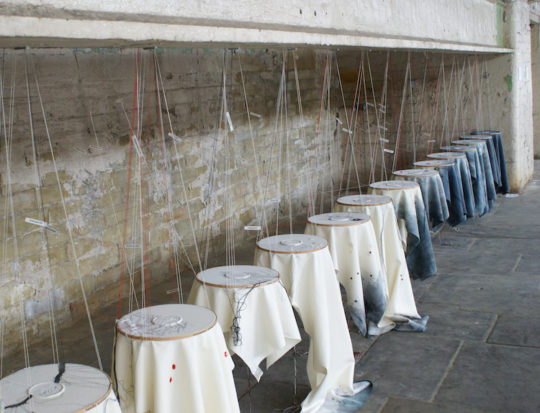
Caroline Bartlett, Stilled, 2013, 7.5 x 1.58 x 2.m, dyed, stitched wool, porcelain
I have carried on using porcelain as one work has led into another.
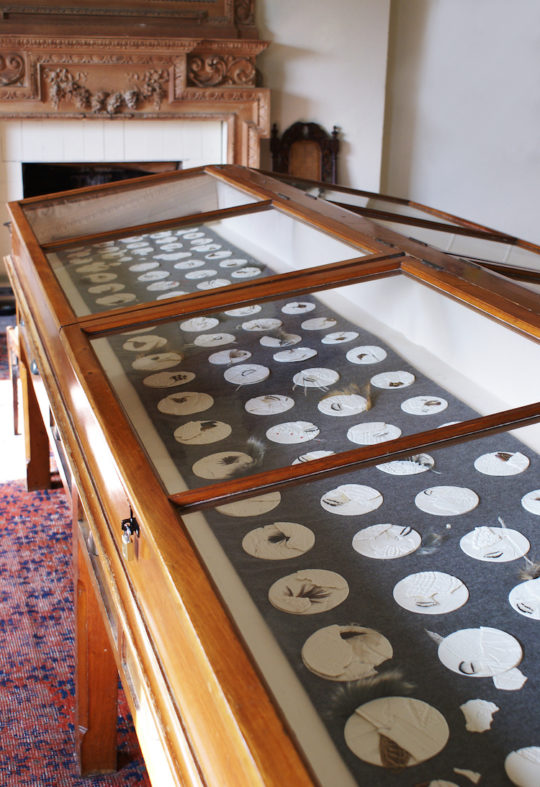
Caroline Bartlett, A stitch in the fragment of time, 2014, stitch, imprinted porcelain
This piece was made in response to Newark Park, a National Trust property which in Elizabethan times had been a hunting lodge.
Establishing connections
Do you use a sketchbook? If not, what preparatory work do you do?
I find a sketchbook to be a key developmental tool; a place for thinking and recording, for the hands on and the unexpected happenings which sometimes occur just by turning a page. I use it to establish connections, select from them and then develop them.
Tell us about your process from conception to conclusion.
In a specific project, I spend a lot of time initially researching the context in a very broad way. Reading, brainstorming, doing visual mind maps and slowly narrowing down my ideas and ingredients. This is accompanied by process investigations as I test and tease out ideas and eliminate dead ends which might come into their own at another point.
Sometimes it might just be a chance remark or line in a text that acts a trigger. I always find this a challenging and uncertain process until I find my direction and can start to run with the idea, tweak, develop and refine it, stepping back, and moving forwards again.
What environment do you like to work in?
My studio or outdoors in the garden when I can.
Who have been your major influences and why?
I saw a smocked piece Untitled 1982 by Polly Binns early in my development and this stayed with me, sparking a realisation of potential direction of travel away from the flat surface. Yoshika Wada through her book Memory on Cloth: Shibori Now, and generous introductions has been another influence.
I have also long admired the work of Anne Hamilton, Anne Wilson and Joan Livingstone.
Essentially though life’s journey is the major influence; experiences and interactions and what permeates into my sphere of reference. John Berger talks about life’s’ experiences folding backwards and forwards on themselves and this notion has resonated with me in the development of processes and ideas.
Tell us about a piece of your work that holds particularly fond memories and why?
‘Stilled’ holds particularly fond memories as part of Cloth and Memory. The construction of this event was so thoughtfully planned by its curator, Lesley Miller. There was enough time in the programme from initial inception through to installation to aloe me to really think about what I wanted to do and to take risks.
I could venture into new territory including porcelain and the site for the work was magical. It was a huge privilege to work with Lesley Miller, and a great experience installing the show and interacting with other artists and visitors.
What advice would you give to an aspiring textile artist?
Keep asking the question ‘what if?’
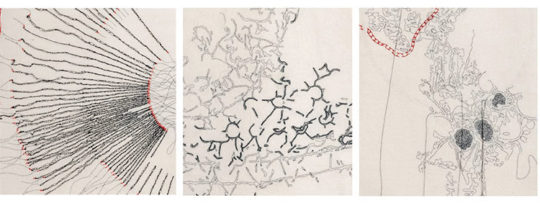
Caroline Bartlett, Backwards, Forwards, 2011, detail
Exhibitions, courses and recommendations
Can you recommend 3 or 4 books for textile artists?
The Textile Reader; ed. Jessica Hemmings, Berg Publishers 2012
Strange Material Storytelling Through Textiles, Leanne Prain, Arsenal Pulp Press, Vancouver, 2014
Contemporary Textiles; the fabric of fine art, ed. Nadine Kathe Monem, Black Dog
On Longing: Narratives of the Miniature, the Gigantic, the Souvenir and the Collection: Susan Stewart, (1984) Duke University Press, 1993.
This is not specifically about textiles but relates to my interests in collections
What piece of equipment or tool could you not live without?
My computer for storing information. My transfer press, sewing machine and pleater are fairly key pieces of equipment but without them, I would simply be challenged to make in a different way.
I had easy and immediate access to photographic screen making facilities but lost this access and as a result developed fresh approaches to my print processes which required no such technological equipment. Having to make work on the hoof, started me using hand stitch to develop imagery.
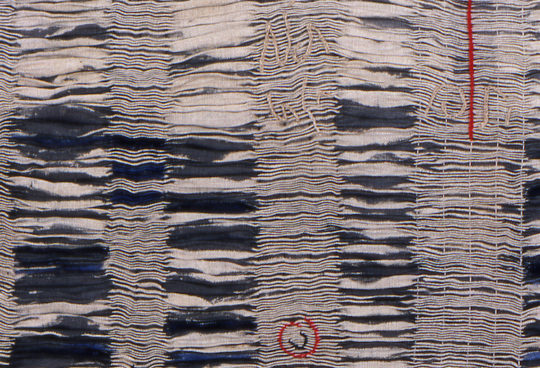
Caroline Bartlett, Annotations, 2006, discharged, pleated, stitched, linen cotton thread, 92cm x 82cm
Do you give talks or run workshops or classes? If so where can readers find information about these?
I have taught for many years at Foundation, degree, MA level and in adult education through from beginners to advanced and have run workshops in various museums such as the Victoria and Albert Museum.
I teach fairly regularly at City Lit and Morley College in London and have just run courses at great independent workshops such as Studio 11 in Eastbourne and Big Cat in Newburgh near Perth.
I start at West Dean near Chichester in November and will be in Australia, Tasmania and Holland next year. I find teaching and facilitating is a two-way process in that I gain as much as I give.
Information is on my website with links to my specific courses.
Where can readers see your work this year?
In October I am showing in Ornament in Manchester.
In November at SOFA Chicago with Brown Grotta Arts.
I am currently working on a project Behind the Wall.
For further information on my work pre-2009 see In the Spaces of the Archive in Craft Design Enquiry issue 1 on Migratory Practices
For more information visit: www.carolinebartlett.co.uk
Got something to say about the techniques, materials and processes used by this artist – let us know by leaving a comment below.
















Thoroughly enjoyed this piece on Caroline Bartlett. The pictures even though I could enlarge them to see some details made me want to see them for real, upclose!
Such beautiful work with incredible depth and meaning. Thank you for sharing and the insight you have provided. I am currently in my third year of a fine arts degree and desperately trying to include some forms of textiles into my fmp. My tutor is not keen because she sees it as contemporary applied arts and not fine arts but I am so in love with manipulated textiles that it’s hard not to find some way of inclusion into my paintings ! Thanks once again.
Fabulous and exciting work but I have to say that I am a colour junkie and all the work appears to have a very subdued pallete. Brilliantly executed and thought provoking.
I greatly admire Caroline’s work and have drawn inspiration and understanding from studying it as part of my OCA degree. Another great article thanks Daniel.